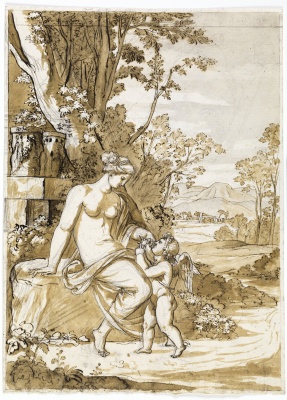Descripción de la Exposición
Pedro Cera is pleased to present the first exhibition of Anton Henning at the gallery.
“Backward Avant-Garde” brings together a vast body of recent and existing works, which like much of the practice of Anton Henning, takes the many legacies of the 20th century Avant-garde movements as their point of departure. Henning’s approach, however, is far to be a simple gesture of appropriation or scrutiny of the many ISMs which have shaped Modernity, characteristic of a post-modern approach, but instead an attempt to revisit and further explore some of Avant-garde’s fruits, with tools and knowledge offered by the present future.
Speed related to progress, growth, or evolution, may this be the evolution of technology or forms, has played a fundamental role in shaping the modern doctrine, forever changing the rhythm of life, the effects of which have very much determined also our contemporary condition. Henning’s attempt to revisit the language of the many Modern movements can be perceived as a way of overcoming Modernity’s imperative of progress and preoccupation with speed, preventing a proper exploration of the formal potential introduced by individual movements. His approach is overall conceptual and yet totally intuitive, generously allowing the sensuality of the media to convey. Through this gesture Henning challenges the legacy of Modernity, turning our attention to the past as a potent source of knowledge and seductive inspiration instead of a hunt for stylistic novelty. Despite his preoccupation with the Modern, Henning’s references also paraphrase the pre-modern, may this be Renaissance portraiture, Baroque landscape, or Programmatic painting of the 19th century. Bringing together elements from various movements and running against the grain of chronological order, his painting can be perceived as a re-activation of seemingly distant pictorial spaces, where the history of art is presented as a contemporary occurrence and an adaptation of its own past, a reinvention of itself.
Like the exhibition itself, also the exhibition title builds on the idea of the familiar. However, the change of its chronological direction generates an unsettling feeling intensified in the exhibition, where the misplacement of the familiar and the fearless introduction of a “new order” point to the vulnerability of the art historical institution, subjected to scrutiny. A profound scepticism of art’s classification and categorization is a crucial element when it comes to Henning’s hybrid paintings and translates in the manner of display and the interior-like approach to space, changing through its attributes and unconventional curatorial guidance not only the behaviour of the spectator but also, and most importantly the way how is art experienced and perceived.
Furniture first appeared in the practice of Anton Henning in the late 90s and has since found its firm place in the artist’s practice. Allowing for art’s utilitarian side, sofas, armchairs, lamps, or rugs transform the exhibition space into a space of comfort and use. The idea of a sterile white cube, a space characteristic of hierarchy, and an artwork’s superiority collapse under establishing a new and prolonged art experience. In this setting, Henning’s paintings become part of everyday life rather than objects of worship. They are relieved of the burden of being perceived strictly as works of art. Their status becomes ambiguous. A similar ambiguity is characteristic of Henning’s sculptural/furniture work, where despite maintaining its formal characteristics and encouraged use, their placement on plinths and small pedestals conceals the clarity of their meaning/purpose. Moreover, the rich display, characteristic of the number and manner in which Henning’s paintings are shown, escapes contemporary institutional norms of display, echoing instead an 18th century French Salon, set, through the vivid and geometric approach to wall painting, against the constructivist backdrop of a Salon de Madame.
“Backward Avant-Garde” is a world of contradictions and incompatibilities, a world of unexpected connections, where seemingly remote worlds transform into elements of an autopoietic system, which through the interreferential reproduction of its elements, challenges, on one hand, established ways of art’s viewing, perception, and interpretation, while on the other, questions the greater institution of art metaphorizing the deconstruction of deconstruction.
—
Anton Henning (1964) lives and works in Berlin and Manker. His work has been shown in numerous institutional solo-exhibitions for example at Zeppelin Museum, Friedrichshafen, Germany (2015); Magasin III, Stockholm (2012); Mamco, Geneve, Switzerland (2012); Talbot Rice Gallery, Edinburgh (2011); De Pont Museum for Contemporary Art, Tilburg, the Netherlands (2009 & 2002); Kunsthalle Mannheim, Germany (2009); Wilhelm-Hack Museum, Ludwigshafen am Rhein, Germany (2009); Gemeente Museum Den Haag, The Hague, the Netherlands (2008); S.M.A.K, Ghent, Belgium (2007); Museum Haus Esters, Krefeld, Germany (2006); MARTa, Herford, Germany (2005); Museum für Moderne Kunst, Frankfurt am Main, Germany (2005); Kunstmuseum Luzern, Lucerne, Switzerland (2004); Kasseler Kunstverein, Kassel, Germany (1998); White Columns, New York, USA (1995); University of Oklahoma, Museum of Art, Norman, Oklahoma, USA (1990) among other.
His work is included in the collections of museums such as Arp Museum Rolandseck, Remagen, Germany; Art Gallery of New South Wales, Sydney; Berlinische Galerie, Berlin; Centre National des Arts, Paris; Kunstmuseum Bonn, Bonn, Germany; De Pont Museum for Contemporary Art, Tilburg, the Netherlands; Frieder Burda Museum, Baden-Baden, Germany; Staatsgalerie Stuttgart, Stuttgart, Germany; Gemeentemuseum Den Haag, The Hague, the Netherlands; Krefelder Kunstmuseen, Krefeld, Germany; LACMA, Los Angeles, USA; Magasin III, Stockholm; MOCA, Los Angeles, USA; Museum für Moderne Kunst, Frankfurt am Main, Germany; National Museum of Art, Osaka, Japan; Neues Museum Nürnberg, Nuremberg, Germany; Sprengel Museum, Hanover, Germany; UCLA Armand Hammer Museum, Los Angeles, USA.

Exposición. 10 mar de 2025 - 22 jun de 2025 / Museo Nacional del Prado / Madrid, España
Cambio de forma: Mito y metamorfosis en los dibujos romanos de José de Madrazo

Formación. 01 oct de 2024 - 04 abr de 2025 / PHotoEspaña / Madrid, España